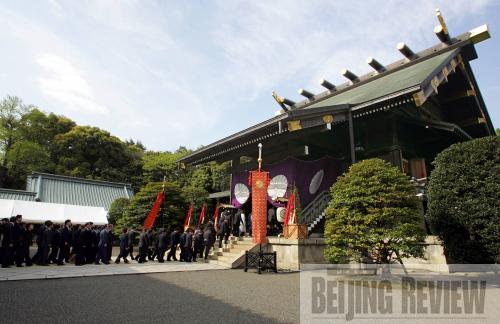|
 |
|
SHRINE WORSHIP: This file photo shows a scene of Japanese parliamentarians visiting the Yasukuni Shrine on April 21, 2006. This year, only one of Prime Minister Taro Aso's cabinet ministers participated in the worship on August 15 (XINHUA/AFP) |
The date of August 15 in Japan was quite different in 2009 from in previous years. Unlike in the past, fewer politicians attended the Yasukuni Shrine worship on the specific date that marked the 64th anniversary of Japan's surrender and the end of the World War II.
As time changes, debates on this historical issue are no longer a focus of the general elections in Japan, said Feng Zhaokui, a senior research fellow at the Institute of Japanese Studies, Chinese Academy of Social Sciences. "Japanese politicians have no longer considered Yasukuni Shrine worship as a good tactic to attract more votes," he said.
The Yasukuni Shrine remains a sensitive topic that can easily cause tensions between Japan and its Asian neighbors. The shrine, located in Chiyoda, Tokyo, is dedicated to the spirits of soldiers and others who died in war.
It collected memorial tablets from war criminals of World War II, including 14 Class A war criminals, in 1978. Since then, Japanese Emperor Hirohito stopped attending the worship ceremonies there.
Current Emperor Akihito has never even participated in the shrine worship since ascending the throne. Former Japanese Prime Minister Junichiro Koizumi, who was in office from 2001 to 2006, visited the shrine six times as the sitting prime minister. His shrine visits, in turn, hurt Japan's relations with its Asian neighbors—countries that suffered heavily under the march of the Imperial Japanese Army during World War II.
This year, neither Prime Minister and leader of the ruling Liberal Democratic Party (LDP) Taro Aso, nor leader of the main opposition Democratic Party of Japan Yukio Hatoyama appeared at the shrine worship. Instead, Aso attended a memorial ceremony for the millions of Japan's war dead in Tokyo and expressed his remorse for the victims of World War II.
Japan, he said, should humbly reflect on its past, lest its people forget the pain the war inflicted on others, the Xinhua News Agency reported. Only one of Aso's cabinet ministers, Consumer Affairs Minister Seiko Noda, visited the Yasukuni Shrine on August 15 this year. But two former Japanese prime ministers—Junichiro Koizumi and Shinzo Abe—still participated.
Feng Zhaokui explained more politicians would prefer not to visit the shrine this year out of political considerations. Aso and Hatoyama, he noted, have now officially kicked off their election campaigns.
The current ruling LDP has been leading Japan since 1955, with the exception of about 10 months in 1993 and 1994.
However, public support for the LDP has been in a continuous slide in the past months, due to the constant corruption scandals that have plagued its ministers. In mid-July, a poll showed the Aso administration's public approval rating was only about 18.6 percent, far lower than that of the Democratic Party.
It is thus very likely that the LDP stands to lose against the Democratic Party during the coming elections.
"The era for political parties to gain votes through participating in the shrine worship has passed," Feng said.
| 